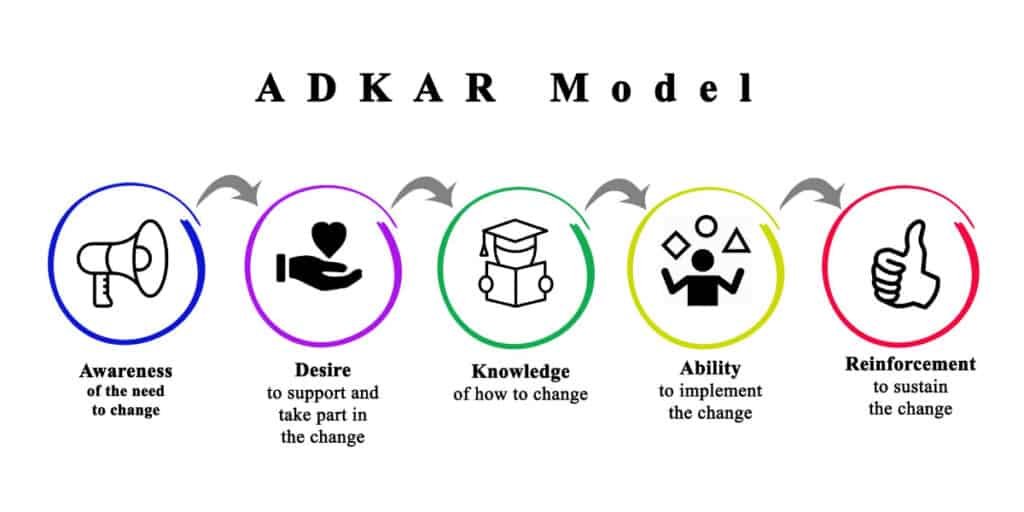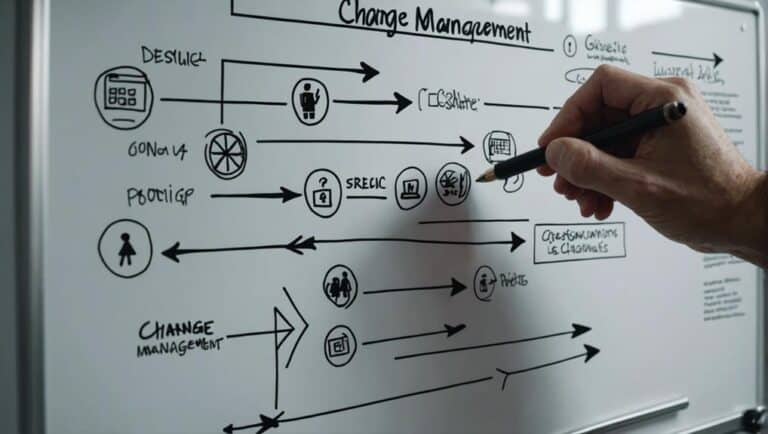Change management is an essential skill for any leader or manager. And yet, it is often misunderstood and misapplied.
In this article, we will explore the definition of change management, the principles of change management, and some techniques for implementing change.
First, let’s start with a definition of change management:
Change Management is the process by which an organization manages changes to its products, services, or processes.
The goal of Change Management is to minimize the disruption to our customers and employees while maximizing the value of the change.
It is up to management teams to decide exactly how this change will be addressed, develop the process and how to best execute it.
Change management involves coordinating a structured period of transition from one situation to another in order to achieve lasting change within an organization.
It also requires leaders to identify key stakeholders such as department heads, senior management and influential employees in order to convey messaging about the change effectively within their social infrastructure of the workplace.
Now that we have a basic understanding of Change Management, let’s explore some of the principles of Change Management.
What are the principles of change management?
Making changes in the workplace can be a daunting task. If you don’t know how to manage change, then your employees may become resistant or resistent, making the process even more difficult.
To combat this resistance and promote planning to incorporate new processes and ideas, it is crucial to understand the main principles of change management. This understanding will create an atmosphere where employees are ready and eager to accept changes.
1. Awareness
Awareness is the ability to recognize a situation, issue, or problem. It can impact change management by helping stakeholders identify potential issues that may arise from implementing a change.
It also helps them stay informed about any changes that are taking place so they can react quickly if necessary.
Continuous awareness of a change’s progress can help ensure it is implemented successfully without any unforeseen consequences or difficulties for those involved.
2. Acceptance
Acceptance is the willingness to accept a change and embrace it. It involves recognizing that change is inevitable, understanding the benefits of the change, and being open to making adjustments in order to adapt.
In order for successful change management to take place, it is important that everyone involved accepts the changes being made.
Acceptance can help reduce resistance or “immunity” towards changes as well as cultural barriers that may be present in an organization’s culture.
By recognizing what not to do when implementing a change, leaders can ensure that acceptance is achieved and positive results are achieved quickly and efficiently.
3. Engagement
Engagement is the process of connecting, informing, and inspiring people with a message or idea in order to gain their support for a particular cause or initiative.
It is important when implementing change as it helps build awareness of the change, creates buy-in from stakeholders, ensures transparency of information exchange, and encourages feedback from end users.
Engagement is vital for successful change management because it helps create an environment where employees feel included in the process and can provide valuable insights that will make sure that changes are implemented effectively.
Additionally, effective engagement strategies will help ensure that employees are aware of all relevant information regarding the change so they can make informed decisions about how it will affect them personally as well as their work processes overall.
Furthermore, a well-crafted stakeholder engagement plan should include mechanisms such as surveys or feedback loops which help collect data on employee perceptions around the proposed changes to inform future decisions regarding implementation strategies or alterations if needed.
4. Leadership
Leadership is the ability to influence, motivate, and inspire others to achieve a common goal. It requires strong communication skills as well as strategic thinking and analysis abilities.
Effective change management requires strong leadership skills. Good leaders are able to communicate effectively with their team members, motivate them towards success, and serve as an inspiring role model during transitions.
This helps ensure that everyone involved in the change process has a clear understanding of its objectives and feels confident about their roles in it.
5. Motivation
Motivation is the driving force behind people’s actions. It can be used to encourage people from within an organization to promote and implement changes.
To create ownership of various changes, it is important to find leaders who are willing to lead its implementation.
You can motivate them with various incentives such as financial compensation, or by reminding them of their previous successes with change or by providing them with verbal persuasion from others who have changed before them.
Additionally, social cognitive theory suggests that individuals need to have self-efficacy (belief that they can succeed in a specific situation) and outcome expectancy (what they expect to achieve) in order for change management efforts to be successful.
6. Communication
Communication is the process of exchanging information between two or more parties. It can be verbal, written, visual or auditory.
Communication is a vital component of change management. It helps to make clear what changes are being implemented and why they are necessary, as well as setting the right tone so that you get the desired emotional reaction from your audience.
Good stakeholder management is also important in order to ensure that you are sending out the correct message to the right people at the right time.
The ADKAR Change Management Model outlines five components that should be addressed in communications:
- Awareness (of need for change)
- Desire (to participate in and support it)
- Knowledge (of how to change)
- Ability (to change)
- Reinforcement (to sustain change over time).

Transparency fosters trust between stakeholders, which is essential for successful implementation of changes.
7. Planning
Planning is the process of creating a plan or strategy to achieve an objective. It is important for change management because it allows the operation’s leaders to create and work with change within certain parameters, guidelines, concepts, approaches and language.
Having a change management plan in place before implementing any changes allows leaders to prepare for potential challenges that may arise during the transition process.
Additionally, having a well-thought out plan will ensure that all stakeholders are on board with any changes being made so there is minimal resistance from those affected by it.
Finally, having a planned approach ensures that everyone involved can remain focused on achieving their goals while also minimizing any potential disruptions caused by changes in operations or procedures
8. Follow-Up
Change management isn’t just about introducing new ideas, but making sure they actually work by following up and evaluating progress. Luckily, there are methods and techniques available to help you do this effectively.
Quantitative Data: Track the progress of the change using quantitative data such as progress reports, metrics and statistics. This will allow you to measure the success of implementation and identify any issues early on.
Qualitative Data: Gather qualitative data by interviewing stakeholders, conducting surveys or focus groups, and observing behavior changes in order to gain a better understanding of how the change is being received by those involved.
Analysis: Analyze both types of data in order to identify common issues that may affect implementation success and resolve them accordingly before they become major problems later on in the process..
Monitoring & Adjustments: Continue monitoring progress regularly with adjustments as necessary until all goals have been met successfully
9. Adjustment
Adjustment is the process of adapting to new conditions and procedures.
Adjustment is an important part of any change management process because it helps ensure that employees are able to successfully transition into their new roles.
By identifying personal concerns and addressing them before implementing a change, organizations can reduce the likelihood of employee resistance or low morale during the transition period.
Adjustment also involves learning new skills, performing different tasks, and generally adapting to new conditions or procedures.
10. Learning
Learning relates to change management because it helps organizations prepare for changes, such as new technologies, policies, or procedures.
By understanding the implications of a change and learning about potential solutions, organizations can better manage the transition and reduce associated risks.
By actively engaging in learning initiatives, organizations can gain the knowledge needed to implement successful change management strategies that minimize disruption for employees and customers.
Learning also helps foster a culture of continuous improvement within an organization, which promotes innovation and enables leaders to identify opportunities for progress in an ever-changing landscape.

How to implement change management in organizations?
Implementing change can be a challenging process, particularly when it comes to organizations with decades-old operations and processes. But organizations are ever-evolving and must adapt to the changing environment in order to survive and thrive.
For organizations to be able to make meaningful changes that stick, change management must be implemented. Change management is a structured process for implementing new ideas into an organization, enabling it to maximize the benefits derived from the change by minimizing disruption.
Step 1: Understand change
Change is the process of transitioning from one state or condition to another. In organizations, change can refer to any significant alteration in policies, procedures, or practices. It is important to understand change because it impacts all aspects of an organization, from its structure and operations to its culture and relationships with stakeholders.
Understanding change is essential for successful organizational transformation as it helps organizations anticipate potential challenges and prepare for them ahead of time.
Understanding the factors that drive changes in an organization’s environment will allow leaders to develop strategies that will lead to successful implementation of changes across all levels of their organization.
Additionally, understanding how changes may impact employees and other stakeholders helps leaders ensure they are communicating effectively with them throughout the process so there are no misunderstandings or miscommunications along the way.
Step 2: Intentionally lead
Leadership is a critical component of successful change management. Leaders must be intentional in their approach to leading change, as they are responsible for setting the tone and direction of the organization.
Leaders must have a clear vision of what they want to achieve and communicate it effectively to all stakeholders. They should also be open to feedback and willing to adjust their plans if necessary. Additionally, leaders should ensure
Step 3: Develop a vision for transformation
Establish a leadership vision that motivates people to take action and drives the need for change.
Thoroughly investigate the “why” necessitating the change, providing concrete evidence to reassure employees resistant to change.
Create a clear vision for change that is aligned with organizational goals, values, and strategies; make sure it is easily understood by all stakeholders involved in the transformation process.
Anchor this vision in internal or external realities that will help inspire employees and motivate them towards successful change journeys in order to achieve desired outcomes quickly and efficiently.
Outline a clear plan of action with specific steps, timelines, resources needed etc., so everyone knows what their role is during this transformation process.
Step 4: Communicate change
Effective communication is essential for successful change management. It is important to ensure that all stakeholders are aware of the changes and understand their implications.
Leaders should communicate the reasons for the change, its expected outcomes, and how it will impact employees and other stakeholders.
It is also important to provide employees with the necessary resources to help them adjust to the new changes.
Understand the change: Gather information about what is changing, why it’s happening, and who will be affected by it.
Plan your communication strategy: Decide on the best way to inform your audience about the upcoming change and how often you should communicate with them over time before it goes live.
Implement your plan: Start by telling them (at least one month before) what is coming their way in terms of changes and value proposition for them; then tell them again (two weeks before) with more details on what’s new as well as resources for onboarding; finally continue engaging with them (nearer to go-live date) so they don’t forget about all the information they’ve received previously on this topic from you or others in their organization/network/etc.

Step 5: Implement change systematically
Ensure that everyone involved in the changes understands what needs to happen – and what it means for them.
Agree success criteria for your changes, and make sure that they’re regularly measured and reported on.
Map and identify all the key stakeholders that will be involved in the change, as well as their level of involvement.
Identify any training needs that must be addressed in order to implement the change, then create a plan to address them accordingly.
Appoint “change agents” who can act as role models for the new approach, while also helping to put new practices into place across teams/orgs/etc.
Find ways to change people’s habits so they become accustomed to using/following/adopting new practices quickly.
Make sure everyone is supported throughout this process by providing resources, guidance, etc. that will help them adjust more easily.
Step 6: Involve all organizational layers in the change management strategy
It is important to involve all organizational layers in the change management strategy. This includes senior leadership, middle management, and frontline employees.
Identify key stakeholders: Senior management and influential employees should be identified as key stakeholders who will be involved in the change management strategy.
Share consistent message: A consistent message about the change and how it is being addressed should be shared with these key stakeholders to ensure everyone is on the same page.
Engage with individuals: Individual members of each layer of your organization should be engaged in order to understand their concerns, questions, and feedback regarding the change initiative or project proposal at hand.
Identify influencers: Influencers within each layer of your organization should also be identified so they can spread positive messages about any new initiatives or changes being made within their department/team/etc.
Senior leadership should be involved in setting the vision for the change and providing guidance on how it should be implemented.
Middle managers should be responsible for ensuring that the change is implemented correctly and efficiently.
Finally, frontline employees should be involved in understanding how the change will affect them.
Step 7: Prepare for the unexpected
Change management is a complex process, and it is important to be prepared for any unexpected issues that may arise. It is essential to have a contingency plan in place in case of any unforeseen circumstances.
Identify potential issues: It’s important to identify any potential issues that may arise from a change before they become major problems. Analyze the change while it is being implemented to identify any potential risks or complications.
Prepare for unforseen events: Create a contingency plan that outlines how to respond in the event of unexpected changes. This plan should include strategies for identifying potential risks and issues, as well as steps for addressing them quickly and effectively. Additionally, it is important to ensure that all stakeholders are aware of the plan and understand their roles in responding to any unexpected changes. Finally, companies should regularly review their contingency plans to ensure that they remain up-to-date
Continuously monitor progress: Monitor progress regularly throughout the implementation process in order to identify any changes that may affect success or cause delays in achieving goals and objectives related to the change initiative or project plan/programme/strategy etc.
Adapt quickly if needed: If necessary, adjust course quickly if something unexpected occurs so that it doesn’t become a bigger issue than it needs be!
Step 8: Communicate transparently and provide specific training guide
Communication is key to successful change management. It is important to ensure that all stakeholders are aware of the changes and how they will be implemented.
This can be done through transparent communication, which should include regular updates on progress and any changes that may occur.
Additionally, providing specific training guides for employees can help them understand the changes more clearly and provide them with the tools they need to successfully implement them
- Communicate what is changing and anticipate what people will want to know. Make a clear case that explains why the change is necessary.
- Anticipate what people will want to know about the change, such as how it will affect them or what they need to adjust to it.
- Provide detailed information about the change, including how it will affect people and what they will need to adjust to it.
- Train staff on how their roles would be different after adopting the change, as well as any additional resources or tools they may need in order to succeed in their new role/position/responsibility etc..
- Be sure to answer any questions or address any concerns that employees have regarding this change so that everyone understands it thoroughly before moving forward with implementation of it into their daily work routine/duties etc..
At least one month before a change is implemented, inform your audience about what is coming their way and provide a high-level summary of what’s changing and the value prop for them.
At least two weeks before the change takes effect, circle back with your audience to “double-click” on the change by reiterating what has been communicated previously and providing any additional pre-read materials they may need.
Nearer to your actual go live date, continue engaging with your audience by summarizing the change again for them, reiterating the value prop, providing new process information and training/resource materials they need to onboard successfully with this new system or process changes..
Step 9: Ensure accountability
Accountability is an important part of successful change management. It is important to ensure that everyone involved in the process understands their roles and responsibilities, and that they are held accountable for any tasks or objectives assigned to them.
To ensure accountability, it is important to set clear expectations and provide regular feedback on progress. This can be done through regular meetings with stakeholders, where progress can be discussed.
- Create clear expectations and metrics for those responsible for implementing change.
- Engage and enable the organization to enact change by allocating responsibility, e.g., decide who will be responsible for coordinating different levels of an organizational change.
- Keep communication open, transparent, and clear throughout the process to reduce ambiguities on responsibility.
- Ensure morale is kept high by creating short-term wins along the way towards long term success of the change initiative/initiatives being implemented/implemented across levels of an organization(s).
Step 10: Assess the progress of change
Assessing the progress of a change initiative is an important part of successful change management. It is important to measure the success of a change initiative in order to determine if it has been successful and identify areas for improvement.
To assess the progress of a change initiative, it is important to set measurable goals and objectives that can be tracked over time.
Track Quantitative and Qualitative Data: Use quantitative and qualitative data to assess implementation success, such as progress reports, surveys, interviews, and other metrics.
Identify Issues Early On: Identify and resolve any issues that may be affecting the change process early on so they do not get out of hand later on in the process.
Identify Common Issues: Analyze common issues that occur when implementing change in order to help improve future implementations of changes in your organization or company culture overall.
Maintain Focus & Pressure To Achieve Desired Outcome: Keep focused on achieving the desired outcome of the change while also maintaining pressure throughout its implementation process in order to ensure success at each step along the way towards reaching it eventually!
Solidify New Status Quo & Transition Organization To Sustain Change: Once implemented , solidify new status quo by adjusting responsibilities & procedures if needed in order to sustain drive & focus until it becomes part of everyday life for everyone involved with this particular change!

Can Change Management Principles Help Employees Embrace and Navigate Change?
Change management principles provide a structured framework for organizations to navigate transitions effectively. By understanding how to explain change management to employees, organizations can help them embrace and adapt to changes. Implementing these principles can alleviate uncertainty and resistance, leading to smoother transitions and increased employee engagement.
FAQs
What is the definition of change management?
Change management is the process of overseeing and facilitating change at any level where it occurs.
It involves coordinating a structured period of transition from one situation to another in order to achieve lasting change within an organization.
This includes identifying key stakeholders, creating a communication plan, conveying the messaging of the change, and outlining how the organization will address it.
Change management also requires leaders to identify key stakeholders, create a coalition with them, and set expectations for what employees can expect going forward.
What are the principles of change management?
The principles of change management include:
- Understanding the Need for Change: Before initiating any type of change, it is important to understand why it is needed and what the desired outcomes are.
- Communication and Education: It is important to communicate effectively with everyone involved in the process and provide them with the necessary education they need in order to understand what changes are being made and why they are needed.
- Identifying Barriers & Opportunities: Before implementing any changes, it is important to identify any barriers that could prevent success as well as any opportunities that could help achieve it faster or better than before.
- Create a Plan & Implement It Step By Step: Creating an effective plan with step by step instructions on how each part of the change will be implemented successfully is essential for success; otherwise, things can go wrong quickly if there isn’t enough planning involved beforehand or if steps aren’t followed properly later on down the line when they’re implemented into practice..
What techniques are used in change management?
In change management, techniques and tools can be used to help implement the four core principles of understanding change, planning change, implementing change and communicating change. Techniques used in successful change management include:
- Co-creation: Letting go of the need to be perceived as experts and instead asking teams what they’d always wanted to try in order to increase motivation and efficacy of change initiatives.
- A behavior-first approach: Understanding that behaviors change attitudes, not vice versa; focusing on creating an environment where teams can try new behaviors together rather than relying on communications plans or catchphrases.
- Different methods for different types of changes: Applying different methods depending on whether changes are “fail safe” or “safe to fail” in order to achieve optimal results with minimal risk associated with failure.
- Continuous connection between different types of changes throughout an organization’s transformation process in order to understand how each one impacts the other.
How can tech companies ensure successful implementation of change?
- Set clear expectations and metrics for those responsible for implementing the change. Provide them with a detailed plan of action, including timelines and goals, so they can measure their performance.
- Ensure everyone involved understands the importance of their role in making the transition successful and is committed to working towards that goal.
- Create opportunities for employees to gain a sense of ownership over the changes by giving them feedback on their progress and recognizing their efforts towards success..
- Create an open environment where questions can be asked without fear of repercussions or judgment; this will help build trust between team members and increase efficiency during the transition process .
- Encourage collaboration between teams; this will help reduce confusion over overlapping responsibilities or conflicting goals while also providing opportunities for cross-departmental collaboration on projects or initiatives related to change management .
What are some strategies for stakeholder management?
Strategies for stakeholder management include:
- Leadership – Leaders must be visibly supportive of change, and should participate in video messaging, system demonstrations, monthly stakeholder meetings, town halls and departmental communications. They should also lead by example by encouraging their teams to adopt change techniques or other actions that promote change within their teams.
- Inclusion – Include everyone impacted by the change in your stakeholder engagement plan by creating a “Change Champion Network” or similar group to bridge the gap between project team members and everyone else; leveraging assessments to determine organizational needs; creating polls to check in with employees; involving employees in pilot groups for training initiatives; designing a feedback loop that encourages open dialogue between stakeholders; running collaborative workshops where they can contribute ideas on how best implement changes within their own departments or divisions/units etc..
- Communication – Ensure effective communication through well-crafted messages that are consistent across all channels of communication (e.g., videos, webinars etc.). Make sure all stakeholders are aware of any changes in timelines/schedules so they can adjust accordingly if necessary!
How can data be used to measure the success of change adoption?
- Set clear expectations and metrics for those responsible for implementing the change.
- Track quantitative and qualitative data to assess implementation success, such as customer feedback, employee surveys, and performance evaluations.
- Use this data to identify any issues with the change process early on and resolve them before they become problematic or affect overall success of the change adoption process.
- Analyze common issues that occur when implementing change in order to better prepare yourself for future changes of similar nature or complexity level of this one you are currently working on now.
What is the importance of employee feedback for successful change adoption?
Employee feedback is essential for successful change adoption because it helps leaders understand the perspectives and concerns of their employees.
This insight can be used to develop better communications, tailored training materials, and more effective strategies for implementing change.
Additionally, when employees feel that their opinions are being heard and taken into consideration, they are more likely to adopt changes willingly and enthusiastically.
Furthermore, employee feedback can help leaders identify areas where adjustments need to be made in order to maximize success with change adoption initiatives.
Finally, by taking into account employee feedback throughout the process of change adoption, businesses can ensure that their changes will have the highest possible level of acceptance among internal stakeholders.
How can leadership promote successful change implementation?
- Identify leaders who are willing to accept and promote change. These leaders should have good communication skills and be able to motivate others.
- Provide incentives for the leaders, such as financial compensation, in order to motivate them further.
- Have many smaller meetings with groups of employees in order to address their concerns about the changes being implemented and explain why they are necessary or beneficial for everyone involved.
- Ensure that all instructions regarding how to implement changes are clear and easily understood by all parties involved so there is no confusion or miscommunication along the way..
How can companies ensure employee morale during times of change?
- Identify personal concerns: Before implementing change, it is important to identify the personal concerns of employees. This can be done by asking them questions about how they feel about the upcoming changes, or by simply listening to their feedback.
- Address emotional concerns: Once personal concerns have been identified, companies should address them in a supportive and sympathetic manner in order to improve their chances of successfully implementing change and strengthen the bond between management and employees.
- Ensure communication is clear and consistent: Clear and consistent communication is essential when dealing with organizational change; this includes regular updates on progress as well as explanations for any changes that are made along the way.
- Encourage participation from employees: Encouraging employee participation in discussions regarding changes can help ensure that everyone’s input is taken into account when making decisions that affect them personally.
What are the key elements of a successful change management plan?
The key elements of a successful change management plan include:
- Obtaining executive sponsorship.
- Defining Change RnR (Requirements, Risks & Rewards).
- Seeking buy-in through identifying and resolving risks, issues and dependencies.
- Establishing KPIs (Key Performance Indicators) and measurements of success.
- Communicating changes to impacted audiences effectively through clear communication strategies that outline what changes are being made, why they are being made and how they will be implemented.





